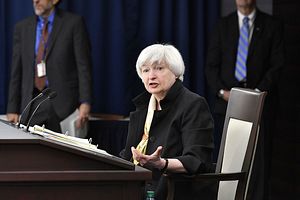Asia’s emerging economies were hit hard by the “taper tantrum” of 2013, when the U.S. Federal Reserve first suggested it would start turning off the monetary tap. Can they survive another shock?
Ultra-low or negative interest rates in much of the developed world have sparked a capital flight back to emerging economies in recent months, with emerging market bonds and equities among the top performers globally in 2016.
Yet as noted recently by Pacific Money, there are plenty of risks ahead, not least including a fragile world economy, high debt-servicing burdens, and the potential for further turmoil should the Fed adopt a more aggressive policy stance.
In a new paper for the Asian Development Bank Institute, economist Peter Tillmann says spillover effects from Fed policy decisions include a withdrawal of capital from emerging economies, a fall in asset prices, and a real depreciation of local currencies.
“The various rounds of quantitative easing (QE1, QE2, QE3), the subsequent exit from QE3 (‘tapering’) and the eventual lift-off of the federal funds rate from the zero lower bound in December 2015 have led to sharp adjustments in emerging markets,” with the unwinding of the Fed’s QE program sparking a sharp and painful reversal of capital inflows.
However, Tillmann, a professor of monetary economics at Germany’s University of Giessen, uses an analysis of Twitter posts to suggest a second type of spillover effect due to uncertainty over future monetary policy steps may be similarly damaging, caused by both financial media speculation and social media commentary.
In 2013, then Fed chairman Ben Bernanke’s comments on the possibility of exiting QE sparked a strong market reaction with “severe” effects for emerging market economies, a reaction that re-emerged more recently with speculation over the timing of Fed rate hikes.
“Uncertainty about the likely course of monetary policy… led investors to adjust their portfolios, thus leading to side effects on emerging markets… Uncertainty leads to a fall in bond and stock prices, a depreciation of local currencies, and an increase in credit default swap [CDS] spreads,” Tillmann said.
Based on 2013 data, the currencies of Brazil, India, Indonesia, and Turkey are seen as particularly vulnerable to an “uncertainty shock,” with South Korea and Thailand considered less vulnerable due to stronger economic fundamentals. Indonesia’s CDS spreads also widened substantially due to is perceived macroeconomic vulnerability, Tillmann noted.
Policymakers Warned
As the European Central Bank and Bank of Japan embark upon their own QE experiments, the taper tantrum experience shows that monetary policy moves should be “as predictable and transparent as possible.”
“When Fed chairman Bernanke gave his testimony [in May 2013], he did mention the possibility of a reduction in bond purchases under QE3 — an obvious consequence of a persistent economic recovery. Although his remarks were carefully crafted, markets nevertheless overreacted,” Tillmann said.
“While part of the overreaction might have been due to an irrational panic, the taper tantrum suggests that carefully communicating policy steps and, in particular, policy reversals, is crucial. This is an important lesson for central banks such as the Bank of England, the Bank of Japan, or the European Central Bank, for which the exit from unconventional measures and the return to policy normalization is yet to come.”
Tillmann contends the Fed learned from its mistakes, with the eventual increase in official interest rates in December 2015, although delayed several times, “very well anticipated by financial markets” due to its improved communication.
“Markets reacted in advance of the actual interest rate rise, such that the eventual decision was received without an increase in volatility. The future path of interest rate normalization will again require clear and predictable policy communication,” he said.
With elevated levels of volatility in early 2016 after the first such Fed hike, having a credible policy strategy is even more important for the Fed, the economist said.
Meanwhile, emerging markets also need to strengthen their own fundamentals, given that domestic weaknesses “make emerging market economies more prone to policy spillovers.”
“A policy that tackles imbalances in government budgets and current account balances, avoids excessive indebtedness, and strengthens domestic financial institutions is best suited to cope with spillovers of any kind. In addition, macroprudential policy instruments are often seen as a promising toolkit for avoiding financial imbalances in the light of volatile capital inflows,” he concludes.
Commentators have suggested that economic fundamentals now matter less in a world of “extreme monetary policies” by many developed economies, despite a longing for a return to normal.
“The Fed has always believed that rate increases and normalization were around the corner, but never been able to deliver,” former U.S. Treasury Secretary Lawrence Summers wrote after the Fed’s recent annual conference in Jackson Hole.
“When the Fed predicted in December that it would raise rates four times in 2016, market participants saw a disconnect from reality. It has been that way for a long time,” he said.
Summers said he “did not see a case” for another hike at the Fed’s next policy meeting on September 20-21, arguing there “is no imminent danger of repeating the 1970s experience where inflation expectations ratcheted up leading to stagflation” and the world economy would be more “robust” with a delayed tightening.
However, the Financial Times’ Henny Sender contends Asia is far from prepared from another U.S. rate hike, whenever it eventually happens.
“If the Fed ever does lift rates again, however incrementally, East Asia is still vulnerable to a repeat of the taper tantrum of three years ago… Whatever the fundamentals, this is a world in which the monetary policy in developed economies still holds dangerous sway,” she said.
With Tillmann’s research suggesting uncertainty may be as harmful as the actual policy decision, the Fed and other central banks have plenty of pressure not to spring any surprises. Asia’s central banks, take note.

































